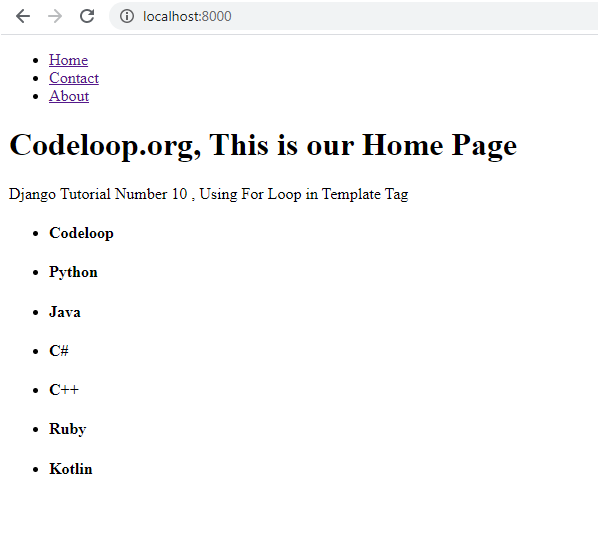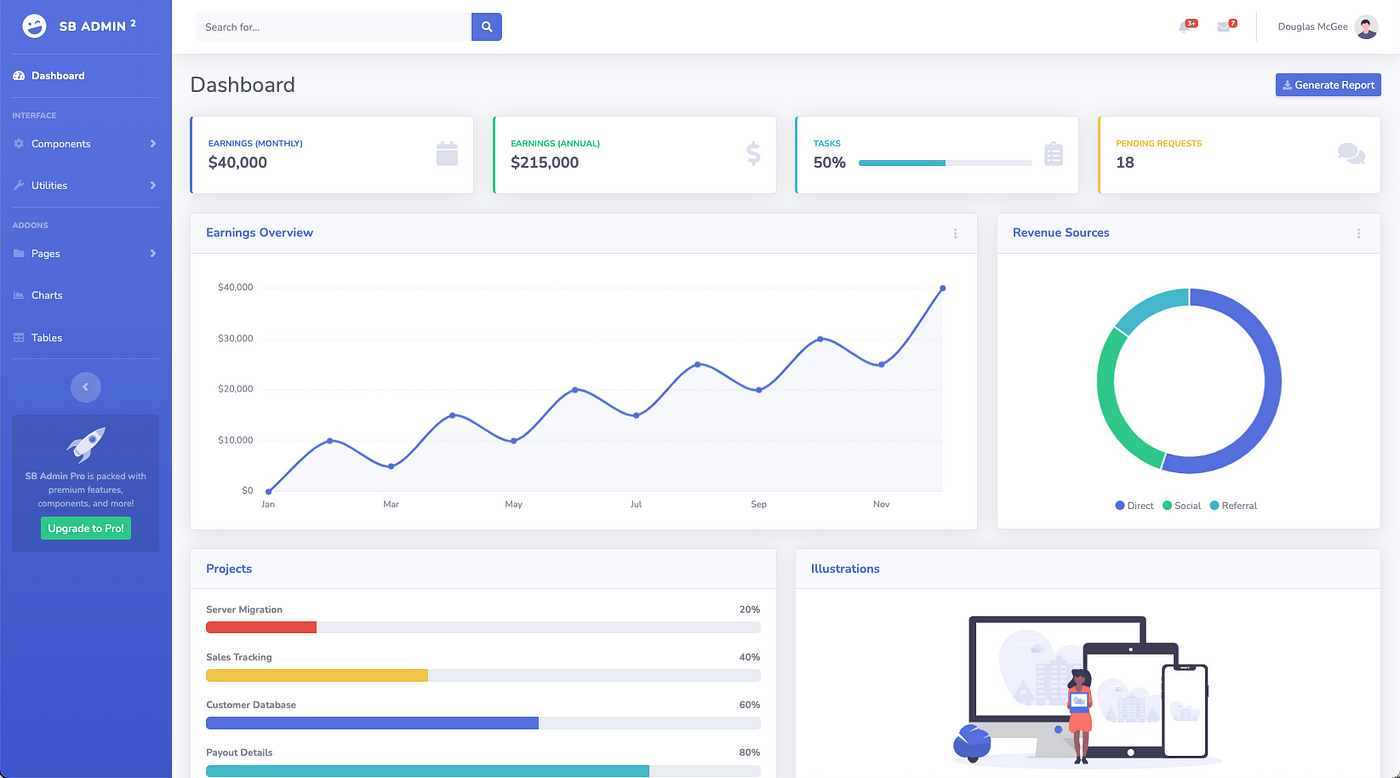Django Template Loop - Web 16 technically it should iterate from 0 to rangelength outputting the user name of the c [i] [0].from_user.but from looking at example online, they seem to replace. In template, you can do: You can find the “ for loop ” syntax below. Web now we can use the data in the template: Web django template for loop. [ product_type_1, [ product_1, product_2 ], product_type_2, [. {% for i in list %} {% endfor %} each line of code is enclosed between {%.%} these. 189 model._meta.get_all_field_names () will give you all the model's field names, then you can use model._meta.get_field () to work your way. Web django provides it. {% for x in mymembers %} { { x.firstname }} {% endfor %}.
{% for x in cars %} { {. {% for x in mymembers %} { { x.firstname }} {% endfor %}. Web django provides it. Web below is the general syntax of for loop template in django: Web i am trying to figure out the best way to loop a given number of times within a django template from an integer field. { { forloop.counter0 }} index starts at 0. Web 16 technically it should iterate from 0 to rangelength outputting the user name of the c [i] [0].from_user.but from looking at example online, they seem to replace. Web demo of the code used below: {% for x in fruits %} { { x }} {% endfor %} run example » example loop through a list of dictionaries: Web django for loop in template to create and use for loop in django, we generally use the “ for ” template tag.
Web below is the general syntax of for loop template in django: Web 16 technically it should iterate from 0 to rangelength outputting the user name of the c [i] [0].from_user.but from looking at example online, they seem to replace. 189 model._meta.get_all_field_names () will give you all the model's field names, then you can use model._meta.get_field () to work your way. {% for item in items %} { { item }} {% endfor %} in the above example, the for loop is iterating over a list. Web numeric for loop in django templates (19 answers) closed 5 years ago. Web below is the basic syntax of a for loop in a django template: For loop is used to iterate over any iterable object, accessing one item at a time and making it available. Web django provides template tags and filters to control each aspect of internationalization in templates. Web django template for loop. Web django provides it.
How to Use For Loop in Django Template Codeloop
{% for x in cars %} { {. Web loop through the items of a list: This tag helps to loop over the items in the given. Web numeric for loop in django templates (19 answers) closed 5 years ago. Web django provides template tags and filters to control each aspect of internationalization in templates.
Django Template Black Dashboard
Web for more information about conditional operators see: They allow for granular control of translations, formatting, and time zone. I need to render block of html code 5 times in template file. {% for i in list %} {% endfor %} each line of code is enclosed between {%.%} these. In template, you can do:
Django Templates part3 YouTube
Web 16 technically it should iterate from 0 to rangelength outputting the user name of the c [i] [0].from_user.but from looking at example online, they seem to replace. Templates are files, much like regular. I need to render block of html code 5 times in template file. Web numeric for loop in django templates (19 answers) closed 5 years ago..
Django Template For Loop python How to change django wagtail's
{% for x in fruits %} { { x }} {% endfor %} run example » example loop through a list of dictionaries: Web numeric for loop in django templates (19 answers) closed 5 years ago. Web 24 answers sorted by: Django provides a template tag for to provide the for loop functionality in django templates. Web django template for.
Django Template For Loop / Django Templates Learn To Create Your First
{ { forloop.counter }} index starts at 1. [ product_type_1, [ product_1, product_2 ], product_type_2, [. You can find the “ for loop ” syntax below. Web demo of the code used below: Web below is the basic syntax of a for loop in a django template:
Django Template For Loop / Django Templates Learn To Create Your First
Some constructs are recognized and interpreted by the template. Web below is the general syntax of for loop template in django: I need to render block of html code 5 times in template file. {% for x in cars %} { {. Web 24 answers sorted by:
Django Template For Loop / Django Templates Learn To Create Your First
Web loop through the items of a list: In template, you can do: { { forloop.counter }} index starts at 1. Web i am trying to figure out the best way to loop a given number of times within a django template from an integer field. I need to render block of html code 5 times in template file.
Try DJANGO Tutorial 18 For Loop in a Template YouTube
Web django template for loop. Web numeric for loop in django templates (19 answers) closed 5 years ago. For loop is used to iterate over any iterable object, accessing one item at a time and making it available. Web loop through the items of a list: 189 model._meta.get_all_field_names () will give you all the model's field names, then you can.
Save Time With this Django Template Bootstrap Admin by Timur
{% for item in items %} { { item }} {% endfor %} in the above example, the for loop is iterating over a list. {% for item in item_list. { { forloop.counter0 }} index starts at 0. Web below is the basic syntax of a for loop in a django template: I need to render block of html code.
How to Use For Loop in Django Template Codeloop
{% for x in fruits %} { { x }} {% endfor %} run example » example loop through a list of dictionaries: Web loop through the items of a list: This tag helps to loop over the items in the given. In template, you can do: Web below is the general syntax of for loop template in django:
Templates Are Files, Much Like Regular.
Some constructs are recognized and interpreted by the template. This tag helps to loop over the items in the given. They allow for granular control of translations, formatting, and time zone. { { forloop.counter0 }} index starts at 0.
Web 16 Technically It Should Iterate From 0 To Rangelength Outputting The User Name Of The C [I] [0].From_User.but From Looking At Example Online, They Seem To Replace.
{ { forloop.counter }} index starts at 1. Web django for loop in template to create and use for loop in django, we generally use the “ for ” template tag. {% for item in items %} { { item }} {% endfor %} in the above example, the for loop is iterating over a list. Web 24 answers sorted by:
Web Numeric For Loop In Django Templates (19 Answers) Closed 5 Years Ago.
Web loop through the items of a list: {% for x in fruits %} { { x }} {% endfor %} run example » example loop through a list of dictionaries: {% for i in list %} {% endfor %} each line of code is enclosed between {%.%} these. Web below is the general syntax of for loop template in django:
Web Now We Can Use The Data In The Template:
{% for item in item_list. You can find the “ for loop ” syntax below. 189 model._meta.get_all_field_names () will give you all the model's field names, then you can use model._meta.get_field () to work your way. {% for x in mymembers %} { { x.firstname }} {% endfor %}.








